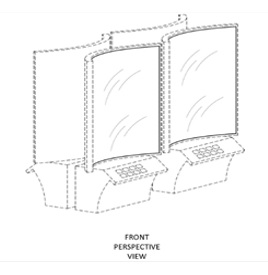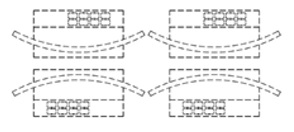A design application by Aristocrat Technologies Australia Pty Limited (Aristocrat) for a bank of gaming machines has been refused because the representations were inconsistent with the product name for the design. The decision shows that products made of assembled components must be carefully illustrated or run the risk of refusal.
Key takeaways
- Components of products must be shown connected together in assembled form to be registered as a single product
- Expert evidence may be of little use during prosecution of design applications
- Arguments in favour of registration of a design based on previous registrations of similar designs are unlikely to succeed
Background
Aristocrat filed design application AU 201816709 for a "bank of gaming machines" (the Design) in relation to four gaming machines arranged in pairs back to back, as shown below.


During formalities examination, the Design was objected to for not showing the named product – a bank of gaming machines – in a "fully assembled" state because the gaming machines were spaced apart from each other in the representations. For this reason, the Design was not in relation to a single product, but four separate gaming machines.
Aristocrat unsuccessfully argued that there was a single product – the "bank" of gaming machines. As the objection was maintained, Aristocrat sought a hearing before a Delegate of the Registrar of Designs (the Delegate) to overcome the formalities objection.
Arguments
Aristocrat submitted evidence from a long time employee, Mr Attwood, asserting that it was common to install and replace gaming machines in groups or "banks". The representations illustrated this type of bank.
Aristocrat further submitted that the bank was a "complex product" under the Designs Act 2013 (the Act), which enabled designs for separately made components of a complex product to be registered. In this case, the individual gaming machines were separately made components of the bank, being a "complex product" and so were registrable.
Aristocrat also submitted that the bank could be a "kit", which may be assembled by an end user. The Act permitted the registration of designs for kits.
Aristocrat further submitted that the Designs Office had previously registered designs for banks of gaming machines. Accordingly, the Design should also be registered for consistency in decision making by the Designs Office.
Decision
The Delegate cast doubt on the usefulness of the Attwood's evidence. Formalities examination did not require any consideration of an informed user, as represented by Mr Attwood. Also, Mr Attwood was not independent, being an employee of Aristocrat.
The Delegate then considered the definitions in the Act for the terms "product", "complex product" and "kit".
The Delegate noted that the definition of "complex product" states that it must be capable of disassembly and re-assembly. This implied that a complex product must be an assembly of its component parts. Based on the ordinary meaning of "assembly", the Delegate held that there must be some physical connection between the component parts.
However, in the Design, none of the gaming machines were physically connected. Accordingly, the bank of gaming machines was not in an assembled form and so did not show a complex product.
Aristocrat conceded that the gaming machines were not physically connected in the bank. Aristocrat argued that they were in fact connected by electronic connections hidden from view and thus were not shown in the representations.
The Delegate rejected that this argument as it assumed that a complex product was shown in the representations when this was not the case.
The Delegate also rejected that the hidden connections should be read into the representations. Such an approach was speculative as there was not any detail of those connections and it would render the scope of the design registration unclear.
The Delegate further rejected that the Design could be a registrable kit. The definition of "kit" was qualified by the requirement that it is only taken to be a product "when assembled". Since the Design did not show the bank of gaming machines as assembled, the Design failed to meet this definition.
Finally, the Delegate agreed that there should be consistency in decisions made by the Designs Office, but said that each design application must be considered on its own merits. The existence of similar registrations does not override the correct application of the Act and there was a small sample of prior registrations cited by Aristocrat.
Accordingly, the Delegate found that the representations did not illustrate a single product, being a bank of gaming machines. Instead the Design showed four separate gaming machines and thus multiple designs. Consequently, the Delegate refused to register the Design because Aristocrat had the opportunity to pay the extra official fees for the additional designs but chose not to do so.
Significance
The decision illustrates that care must be taken when preparing representations for a design that it shows a "product" within the definitions of the Act. In this instance, the apparent lack of connections between the gaming machines was fatal to the registration of the Design.
The decision also illustrates that expert evidence may be of little assistance during formalities examination. Also, arguments in favour of registration based on previously registered designs have little persuasive merit and are unlikely to succeed.
The content of this article is intended to provide a general guide to the subject matter. Specialist advice should be sought about your specific circumstances.

